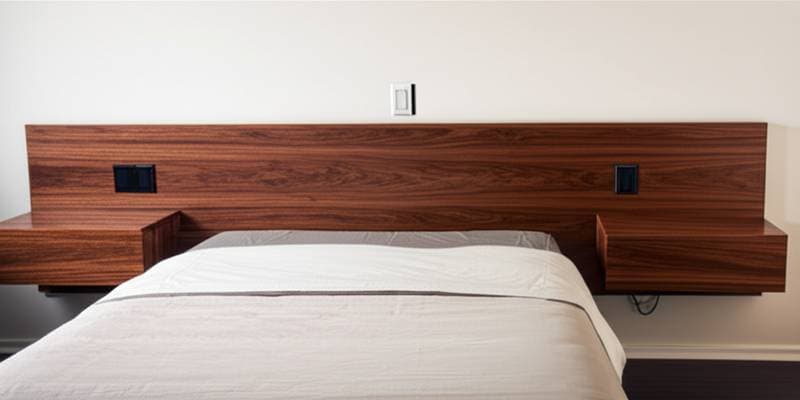Floating Nightstands: Reclaiming Floor Space in Compact Bedrooms
In a 160-square-foot bedroom, every inch counts. Wall-mounted floating nightstands offer a practical solution by elevating storage off the floor, creating an illusion of spaciousness. These designs not only free up valuable walking area but also integrate seamlessly with modern aesthetics, enhancing both form and function.
Key features include integrated warm LED strips beneath each cabinet for a soft ambient glow. Built-in grommets and rear outlet boxes manage power needs discreetly. Soft-close undermount slides paired with touch-latch drawers ensure quiet, effortless access. Positioned at 22 inches from the finished floor, they align perfectly with the mattress top, promoting ergonomic convenience.
These elements combine to support both practicality and visual harmony. By suspending the furniture, designers blend wall, floor, and lighting into a cohesive plane that transforms the room's atmosphere.
The Advantages of Floating Nightstands
Floating nightstands minimize visual clutter. Grounded furniture often segments space and interrupts lines of sight. Elevating storage introduces an open feel, akin to recessed wall niches. This style complements contemporary, Scandinavian, and minimalist decor, while warm woods or painted surfaces adapt it to traditional settings.
Without legs, maintenance becomes straightforward. Robotic vacuums navigate freely below, and dust accumulation in hidden spots diminishes. The exposed underarea also enhances light bounce, brightening compact spaces.
On a functional level, these nightstands allow customization. Tailor widths to match bed dimensions, adjust heights for personal preference, and incorporate lighting without trailing wires. When combined with wall sconces or pendants, tabletops remain clear of oversized lamps, fostering a streamlined bedside.
Consider the psychological impact: lifted furniture draws the eye upward, expanding perceived room size. In urban apartments or guest rooms, this approach maximizes utility without sacrificing style.
Planning and Installing Floating Nightstands
Preparation forms the foundation of a successful installation. Verify wall composition first, as each cabinet anchors to studs or a reinforced plate. A standard empty nightstand weighs about 15 pounds, but loaded capacity can reach 30 pounds, demanding robust fixation.
Step 1: Establish Dimensions
Assess bed size and desired clearance. For a queen mattress, position nightstand centers at least 28 inches apart; kings require 36 inches. Opt for depths of 12 to 16 inches to maintain easy reach while avoiding protrusion into traffic paths. Sketch elevations to visualize balance against the headboard.
Step 2: Integrate Electrical Elements
For concealed lighting or charging, plan wiring in advance. Engage a professional to install recessed outlets behind the cabinets. Incorporate cord channels within the structure to route cables invisibly, preserving a clean facade.
Step 3: Select or Construct Units
Ready-made options abound, but custom builds offer personalization. Start with plywood or MDF cores, veneered in oak, maple, or walnut for durability and elegance. Reinforce with hardwood edging on vulnerable corners. Finish with matte polyurethane or penetrating oil to accentuate natural grain patterns.
Step 4: Secure the Mounting
Employ French cleats or heavy-duty steel brackets rated for double the anticipated load. Level the cleats precisely and fasten into studs, typically spaced 16 inches apart. Perform a stability test with weighted objects before adding personal items.
Step 5: Curate the Aesthetic
Maintain simplicity on surfaces: a compact lamp, single book, or slender vase suffices. Complement with overhead or wall lighting to amplify the levitated vibe. Experiment with textures, such as linen shades or metallic accents, to layer interest without overwhelming the minimalism.
Enhancing Storage Efficiency
Interior organization elevates daily use. Install adjustable dividers to compartmentalize electronics, eyewear, and reading materials. Line drawers with felt to mute closure sounds and protect contents. Cut small rear notches for cable passthrough, ensuring devices charge without clutter.
In shared spaces, mirror designs on both sides for balanced symmetry. Consider soft-touch hardware to prevent nighttime disturbances. These refinements promote order while upholding the serene visual flow.
Budget Considerations and Scalability
Expect custom pairs to cost between 350 and 900 dollars, varying by wood type and detailing. Pre-fabricated versions begin around 150 dollars per set. Factor in 100 dollars for professional installation, particularly if wiring modifications occur. Over time, the adaptability justifies the expense: relocate beds or refresh floors, and the nightstands endure.
For larger applications, extend the concept to floating shelves or media consoles. Scale materials accordingly, opting for lighter hardwoods in expansive areas to avoid heaviness.
Perspectives from Design Experts
Hannah Lee, lead designer, views these pieces as integral architecture. "We position floating nightstands to frame the bed and guide light across surfaces," she explains. Proportion remains paramount: align cabinet tops with mattress edges for unified composition.
Homeowners report swift benefits. "The space feels doubled," they note. "More rug shows through, and cleaning halves in effort."
Essential Lessons
- Wall-mounted nightstands eliminate floor obstruction and reduce visual density.
- Precise height alignment harmonizes the bed ensemble.
- Concealed utilities banish wire tangles.
- Simplified upkeep and contemporary flair suit tight quarters.
- Bespoke or assembled choices accommodate diverse finances and tastes.
Embracing the Transformed Bedroom
Mounting storage elevates a routine task into a room-redefining endeavor. Wood's inherent warmth pairs with inherent convenience, yielding airy expanses. Residents enjoy sustained ease, from effortless tidying to inviting rest, in environments that breathe freely.
